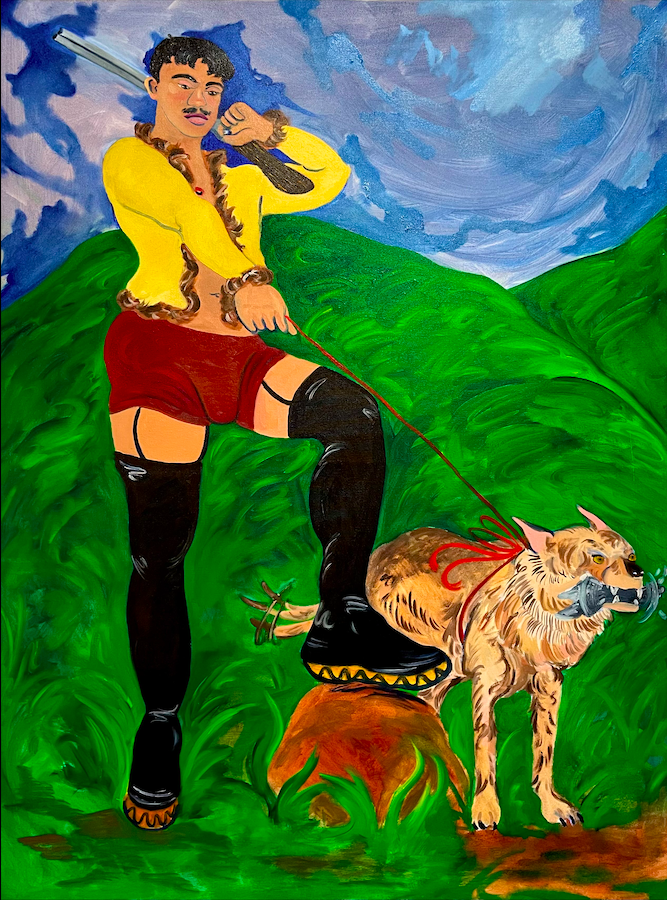On the occasion of his month-long residency at Palazzo Monti, Brescia, I meet with the Chicago-based artist to discuss avatars, the ‘fag fatale’ and allegories.
It is a sunny afternoon, the air is energizing and spring is blossoming. This also means you are gifted with the first timid sweatiness of the year and walk around adorned by an impalpable pheromonal nebulosa. Fair enough for me.
Partida shows me the way up to his studio while, like a true Virgil, he educates me on the 1700s frescoes of the Palazzo, now artist residency and exhibition space, founded by Edoardo Monti in 2017.
We get to the sun-drenched studio, and Ricardo starts introducing me to the works he’s been producing in the past couple weeks.
Ricardo Partida I think of them as avatars or characters. The idea that a copy of a copy of a copy becomes a new entity, something “Other” and autonomous, also informs the work. Do you know about Kardashian Kolloquium?
He shows me an Instagram post by Kardashian Kolloquium depicting Kylie Jenner from pre-puberal to stylized avatar.
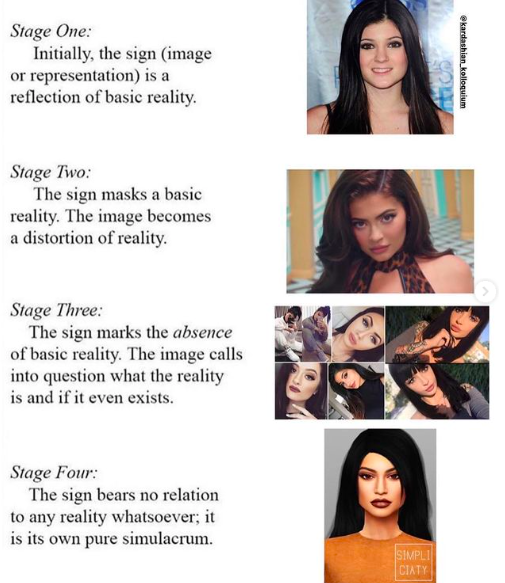
Ottavia Lunari Not familiar, but it certainly reminds me of Simulacra and simulations. The copy of the copy loses its relation to the original, it becomes a representational automaton.
RP I feel that such concept found a place in my practice. I guess everything branches out from a painting I made back in 2019 that represents the first copy onto which I built the following works.
The ongoing theme is for sure the ‘fag fatale’, an effeminate male, a gender-ambiguous character that does not necessarily suggest the idea of seduction but almost demands it.
There are power structures at play, these avatars influence and are influenced by the power of negotiation.
I have them looking straight at the viewer, almost they challenge it.
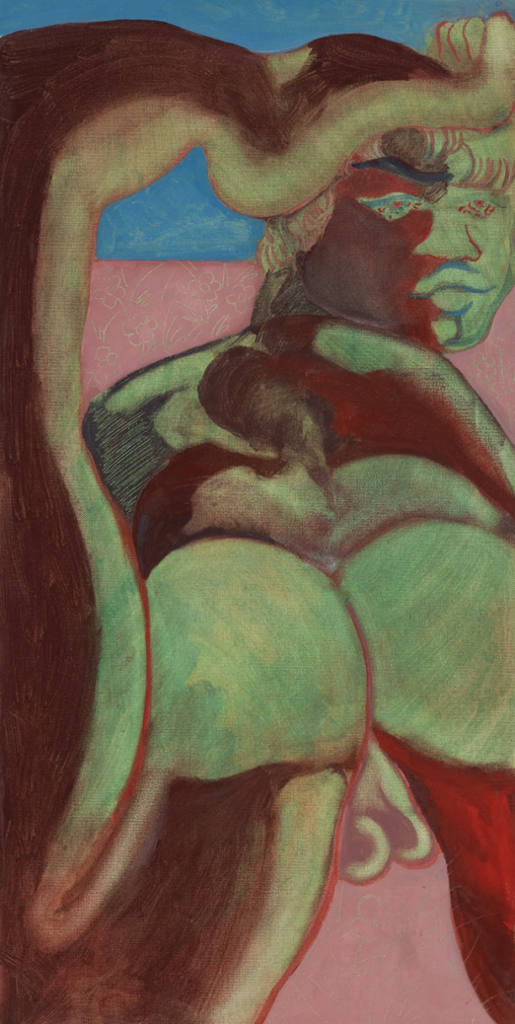
OL Yes, even when the protagonists look out directly to the viewer and bare it all, it is always on their own terms. I feel your work is able to operate synchronically on two levels of proximity: that of quasi-voyeuristic closeness, and that of a gaze relegated to the outside, or better: the gaze is equally demanded and repelled. They request celebration but stop the viewer before it gets fetishizing.
RP Sure. They are able to draw you in and push you out. I find that relationship very earnest. In Chicago when I am navigating the space, I walk around, take the train… You know, I am a very obviously gay-looking person. I sense that everyday of my life I have to choose my own happiness over my safety? I feel that sometimes that allows me to navigate through these spaces and kind of be left alone, like when you’re alone on the tube at night and you want to look as if you had a bad day to be left alone, I feel that look repels people and contextually informs me on the ways of seduction, of desire.Living as a queer person navigating through space, I believe that this kind of negotiation is essential to ensure safety and informs me on places where I may be o may be not wanted, asking me to find somebody else of the community to have that safety ensured.
OL You feel like you have to negotiate your presence in that specific place, in a way?
RP Chicago is a very diverse environment while it is a very segregated city. There’s definitely spaces where you can see more Liberal presence and places where definitely not.
I think of the gaze as a way of arming myself and a way of disarming someone. I feel like femme-spectrum people have learnt to navigate space while signaling to each other whether it is a safe space through not necessarily verbal communication.
OL I wonder if that negotiation contributes to feeding what I perceive as a defiance of spatial and temporal belonging in your work. By negating the viewer the means to locate your protagonists, by creating this ambiguity of belonging, they are able to transcend the diktat of normative thinking. Is there a longing for new mythologies, that would redeem the untold of History and challenge current power dynamics? As of the genre, mythologies escape time and geographical location in order to convey an eternal argument.
RP So, in order for me to make the work ‘digestible’, not necessarily ‘easy’ but digestible while looked at, I like to stand on the shoulders of Art History. For example, relating it to the Contrapposto or the reclining pose which is so articulated with the idea of antiquity, this lounging pose belonging predominantly to female figures in painting… I am not necessarily trying to dismantle these canons, but mostly expand the dialogue with them. So I stand on the shoulders of History, whether it is interpreting the Eros, or the Bacchus, playing with the idea of this indulging character… I think of these avatars as interpretations of Bacchus as well as Cupids…they’re allegories of desire, of passion, but at the same time of jealousy and defiance, and again, negotiation. There’s a text by Carol Ockman from 1995 titled Ingres’s eroticized bodies: Retracing the serpentine line where she talks about how Ingres wanted to create this ‘Other’ in pictorial language. He portrays the ambassadors as these big muscular machos and the female characters in the back, but he wanted to interpret Achilles and Patroclus in a different way, so he articulated these sinuous lines into the figures creating a more elongated appearance to differentiate a character that was more domestic and manifestly taken care of, and usually lounging, versus a stronger, more like DC, Marvel…
OL … a more militarized body?
Ricardo shows me the Ingres…
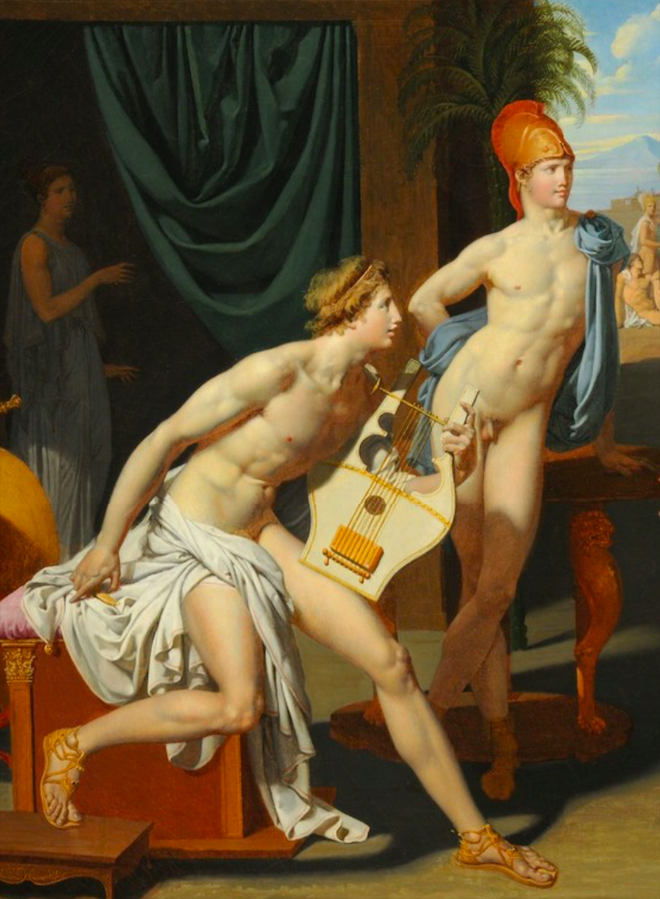
RP We get the differentiation: we have women in the back, and then we get the ambassadors and then we get ‘the Others’, this elongated figure where you can see the line, so you begin to see the seduction…
OL You should read this book then, by the feminist philosopher Adriana Cavarero, Inclinations: A Critique to Rectitude. She questions how the vertical posture, a signifier of moral rectitude, is conventionally attributed to the ‘masculine’, while the ‘feminine’ reclines and is inclined, thus it loses balance while subjugating itself to such inclinations. She goes to unprecedented lengths as in what a line can represent.
RP Yes, I find it so interesting, I indeed usually have them lounging, and I think of this kind of twist that implies dynamics…
OL La Figura serpentinata, right? I guess you don’t exclusively employ it to add dynamism, but to praise the erotic body altogether.
RP Exactly. I always think about how historically we have associated the feminine with the Serpent, which represents, traditionally, the fall of man… for example if you see a very effeminate man you would associate them with being swooshy, with being tricky and often when you see similarly portrayed characters in comics or novels like Dracula, an aristocrat and bourgeois persona, we submit that they’re the villain, as these are all very well taken care of figures, while if you see a very physically strong individual you immediately attach them to heroic qualities, strength, purity and honesty. Although these notions are fed to us through antiquity, they colonize paintings, they create this dominant narrative till today of what the feminine and the masculine should be. I think a lot about being and representing the Other and being a mixture, which imposes you to negotiate with yourself.
OL Of course physical qualities are being linked to morality and ethics in the Neoliberal, ‘work hard’ narrative-driven society.
RP Yes, for sure there’s this contraposition between the heroic image and a more sensual, indulging one…
OL Exactly. I wondered if the avatars aim to be heroes, or anti-heroes? Are they both, do they oscillate? As you mentioned, you borrow a lot from pop culture, the aesthetic, the proxemics, as in Friendly Fire, where we meeta lascivious Robin, perfectly serpentinated, or The storm, a muscular figure with Godzilla energy…
RP The Fagzilla! It is very Only Fans. I think a lot about the promotion of OF, and of this simulacron of the Kardashians that I mentioned. Not just in the realm of Theory, but also on a tangible level: the consumerism happening, fast fashion, this synthetic fabrics mania, which are massively reproduced by these models, these online entities… I had a show at Deli Gallery in 2021 Death of a Hero, Rise of a Champion… I think of them as an ongoing project that asks what would it be like to kill a hero and create this other entity who becomes ambiguous of what it is good. It comes down to the relationship you have with what these figures might represent and their aesthetic. So these characters that I depict consciously want to be ambiguous on the spectrum of where they stand.
OL Also, you often gift them with these zoomorphic features, sometimes they resemble a faun or a sexually-charged devil… I sense that hybridization plays a prominent role throughout your practice. It has something to do with the automaton and reproduction, as we mentioned earlier?
We are now obsessed with our bodies, we are constantly trying to optimize it, we acquire devices, machines of any sort to be more efficient, productive… I frequently happen to wonder if the optimization of the body is coming to such an extreme that we aspire to achieve a chimeric body? To become Other. Maybe it’s the driving agent, not the endpoint.
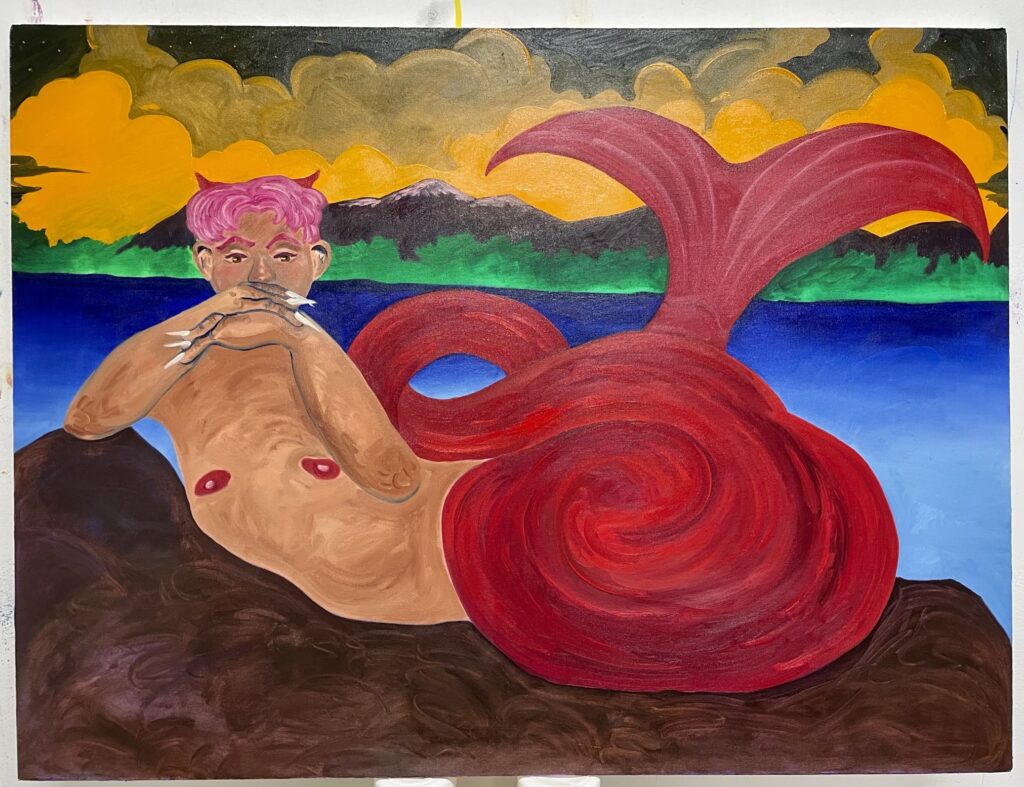
RP Totally, the concept of the chimera is so reminiscent of the practice, there’s clearly a mash-up, a combination, and sometimes I’d even go as far as to making it like a feline, like a dragon, these beastly figures… I put horns on them… They are signifiers, not merely religious signifiers, but also of what we dim good and evil, honest or dishonest, so yes, they are consciously zoomorphic. I’m also into the Furry fandom…
OL …wanted to ask you about that! I see it
RP I find so interesting this idea of creating an avatar… and actually Chicago hosts one of the biggest furry conventions of the US! I think it is interesting as it spills over in the gay community, where there’s the idea of the puppy play, of the master and commander, and the submissive. There’s a power shift. So I think about the way in which the work becomes even more ambiguous by fusing it with an animal…
OL It’s disarming. I realized I was asking myself: Am I finding a cat sexy?
RP Yes, that cat looks kinda sexy. I like challenging the viewer with other ways of seduction.
I incorporate serpents, felines, as they are so gender dominative… Also, I do not chisel them, I don’t make them as super Adonis, in a way I think I’m trying to demystify the Adonis, and create this other narrative where there’s no reminiscence of the David. Maybe it’s even an anti-Adonis, a more voluptuous figure. I don’t necessarily relate to femininity, I think I associate it more to leisure. These are characters that are greatly taken care of. And I guess you can think the same of a domesticated cat, he won’t do anything for you, but you will do obviously something for him and in exchange he will give you affection.
OL Negotiation comes back again, doesn’t it? So the anti-Adonis is even more an element of ambiguity, as they play with the practice of self-care or being cared for, a practice traditionally attached to the feminine.
RP Yes, it is a way of pushing through or like inserting itself as a figure that is desired, that is equally a product of society and of its negotiation of desire. Additionally, in the past I frequently received questions on why these avatars looked so youthful, almost like teenagers, why they always had this sense of youth.
Of course we have this dictation for which we associate the feminine to youth and the masculine to age, so if signifiers of age like a beard, a mustache, body hair are missing and these elements are attached to the masculine… this goes to contribute to the ambiguity. I like the idea of youth to play with genders.
OL In a way it is as if the viewer were deprived of the chance to exercise their own norms because of the missing signifiers. It is disempowering.
RP I feel there are these holes for you to fill them.
OL Youth is strongly tied to freshness and joyousness, obviously. I believe that depicting buoyancy can represent a form of resistance, even revolution, towards society. I think that, even more so recently with this trauma porn dominating every flat surface, people are expecting some kind of struggle. I guess that when it comes to gender discourse and minorities representation, this hyper-fixation for struggle only contribute to constructing temporary altars which hardly offer space for dialogue on self-affirmation.
RP Definitely. I think of them as characters of these counter-stories. Creating avatars help me in doing so.
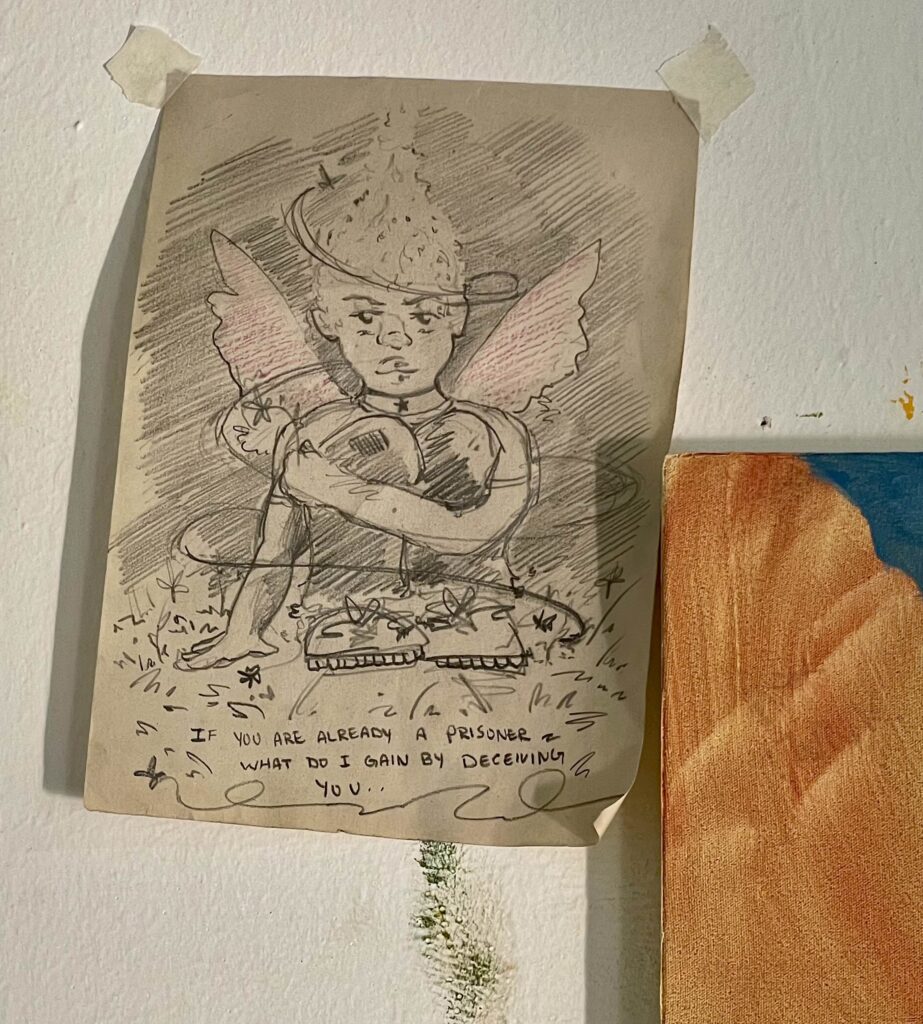
Ricardo shows me his works more in detail. He wrote down a track by MF Doom whom I happen to love.
RP I feel it so reminiscent of the work. They aren’t prisoners of gender dictation, the way we are fed perspective on gender and gender norms. 'What do I gain by tricking you? You are already fool.’ There’s again the question on negotiation, which it’s more a negotiation with yourself, with what you stand for. They have this kind of party girl outfit, they feel more leisured. He’s not afraid of walking around like this. As I mentioned earlier, I feel it is revolutionary to sometimes choose my happiness over my safety… you should be able to have agency, keep that relationship with yourself, keep that idea you have of yourself and the relationship with your environment.
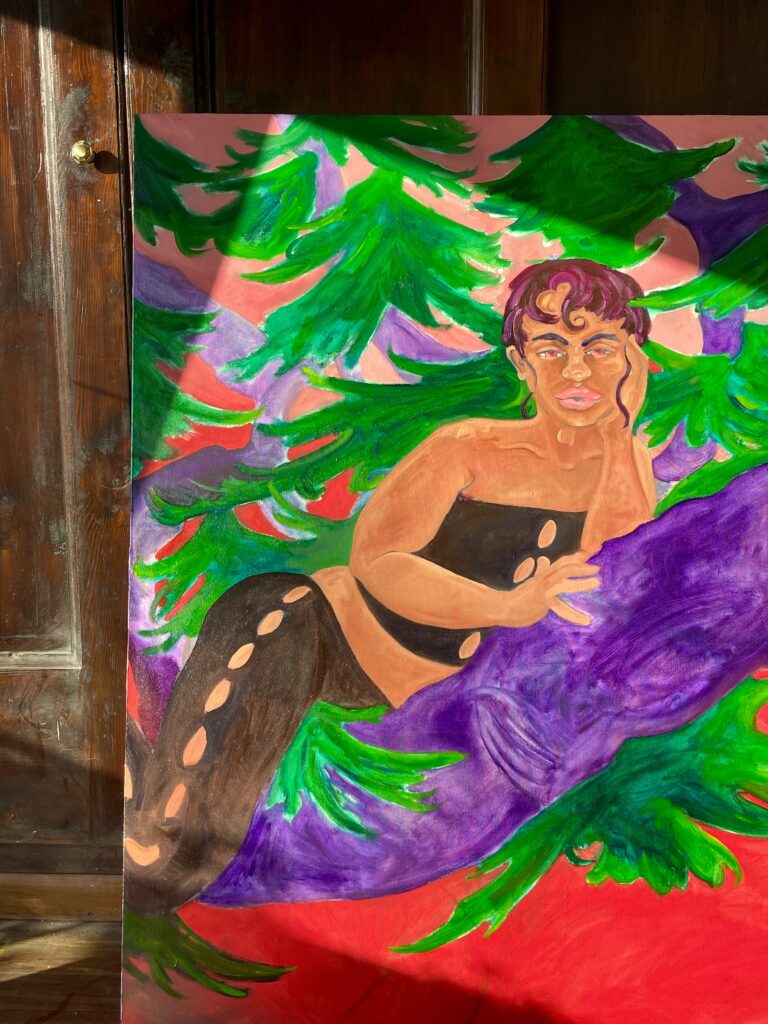
Here I was thinking… you know, this idea of the kitten stuck on the tree, and the firefighter goes up to get it but the cat scratches them because it is where it wants to be. It got there for a reason. It is looking down on you, there’s an assertion of dominance. So this character is lounging in this feline pose, and the attitude recalls the image of the deceiving serpent, this idea of the Evil…
In the States, there is this popular fad, or dominant narrative let’s say, that we queer artists make work that is tender, or that is about love in a way of showing our hetero-counterparts that we are able to love, to nurture.
View from the red pine, 2023, Oil on canvas, 120 x 90 cm
OL …an affirmation by way of allegedly true universal values?
RP Yes. So, less about sex, more about love. As a way of finding that common ground…
In my work I go in the opposite direction. In fact these avatars work like mirrors of what you can consider sensual but it’s under my own terms and I am feeding it to you, and you can end up feeling disoriented, maybe you reevaluate and reassess your thoughts and relationship to bodies and politics of representation.
In each of the paintings there is a dominant colour. As I mentioned, I like to stand on the shoulders of Art History and the tradition of painting as a way of challenging them. And creating different Venuses, for example.
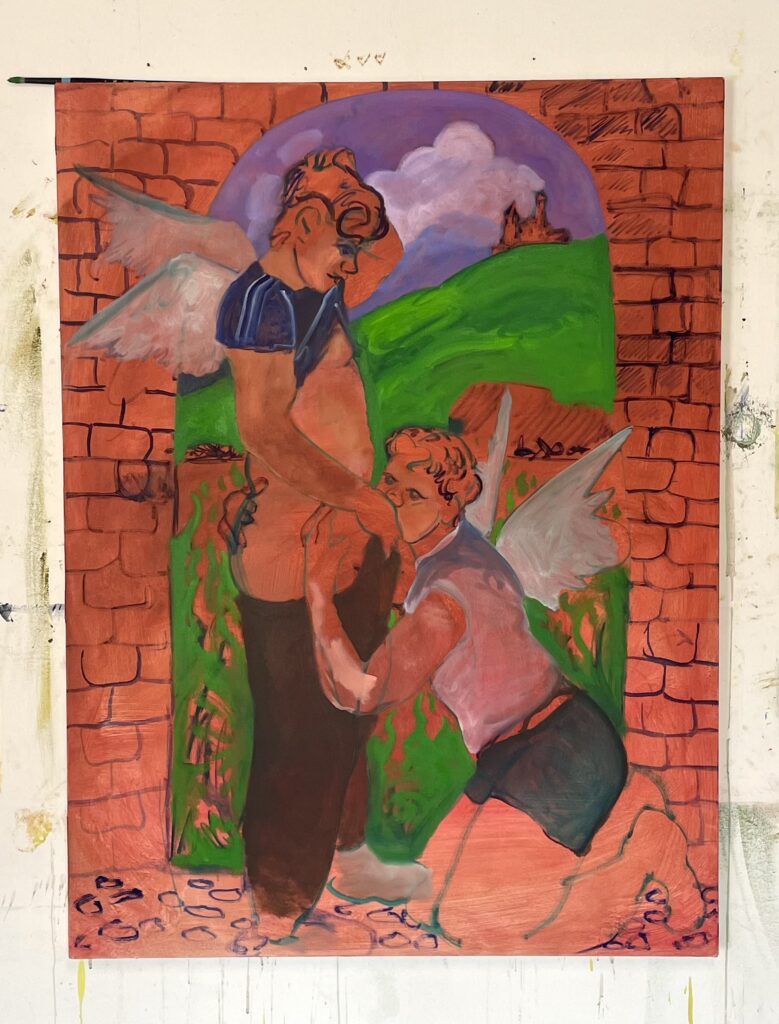
Ricardo Partida, Bacio Bresciano, 2023, 90 cm x 120 cm, oil on canvas 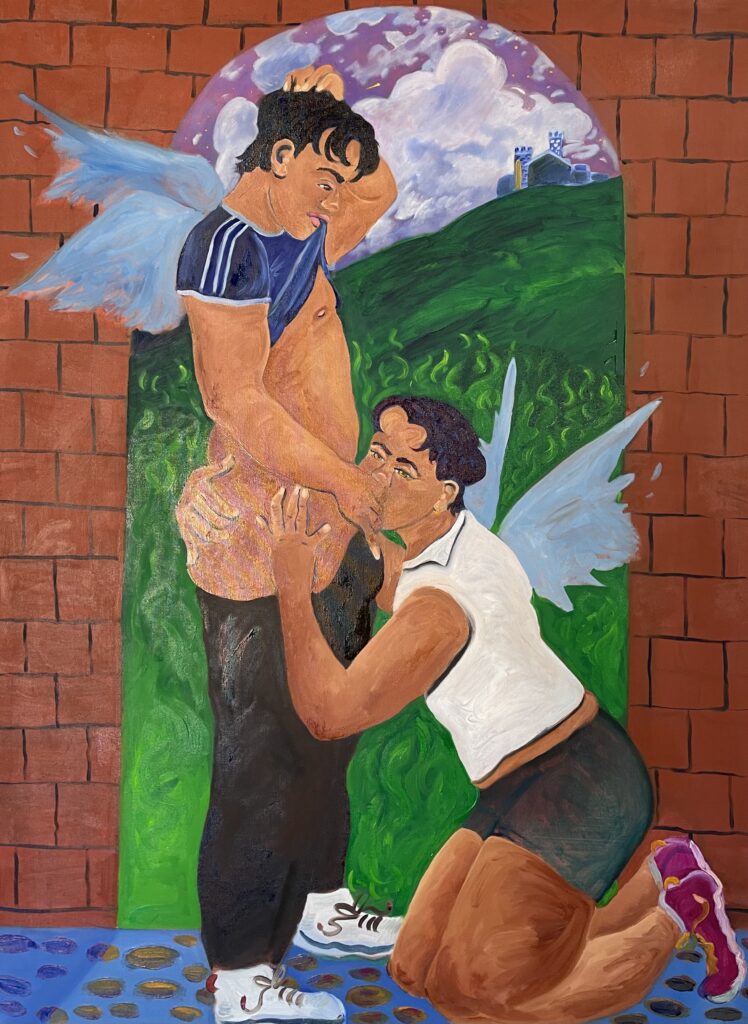
We go on talking about masculinity à la Tom of Finland and what would be like to imagine a softer masculinity, multiple masculinities, an Anti-Adonis, instead, or on top… A Cupid face with pierced nipples and leather boxers. Wanting to calibrate yourself and your environment, being soft but strong. Is masculinity a performance before it is questioned or it becomes one afterwards?
I let that question sink in. We take another bite of ice cream under the melting sun.
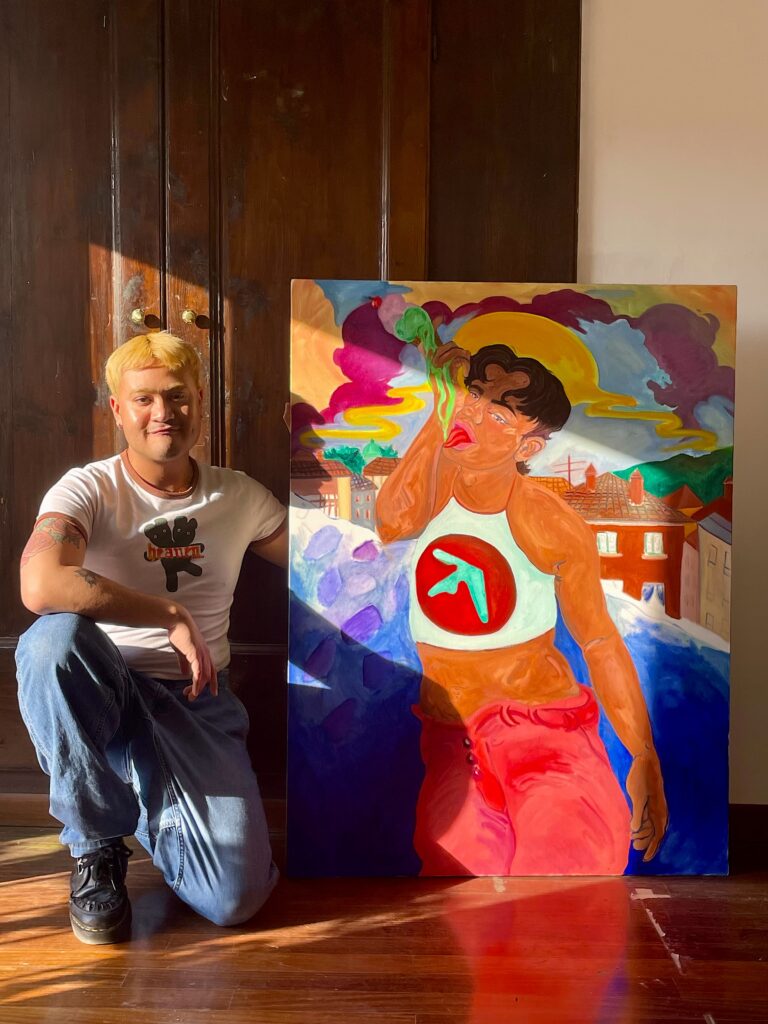
Ricardo Partida (b. 1990) currently lives and works in Chicago, Illinois. He received an MFA in Painting and Drawing from The School of the Art Institute of Chicago in 2020 and a BFA in Studio Art from the University of Texas Rio Grande Valley in 2017. The artist will be participating to Dallas Art Fair with Martha’s Contemporary, Austin, Texas, and has upcoming shows at Monti8, Latina, Italy, and LVL3, Chicago, Illinois.
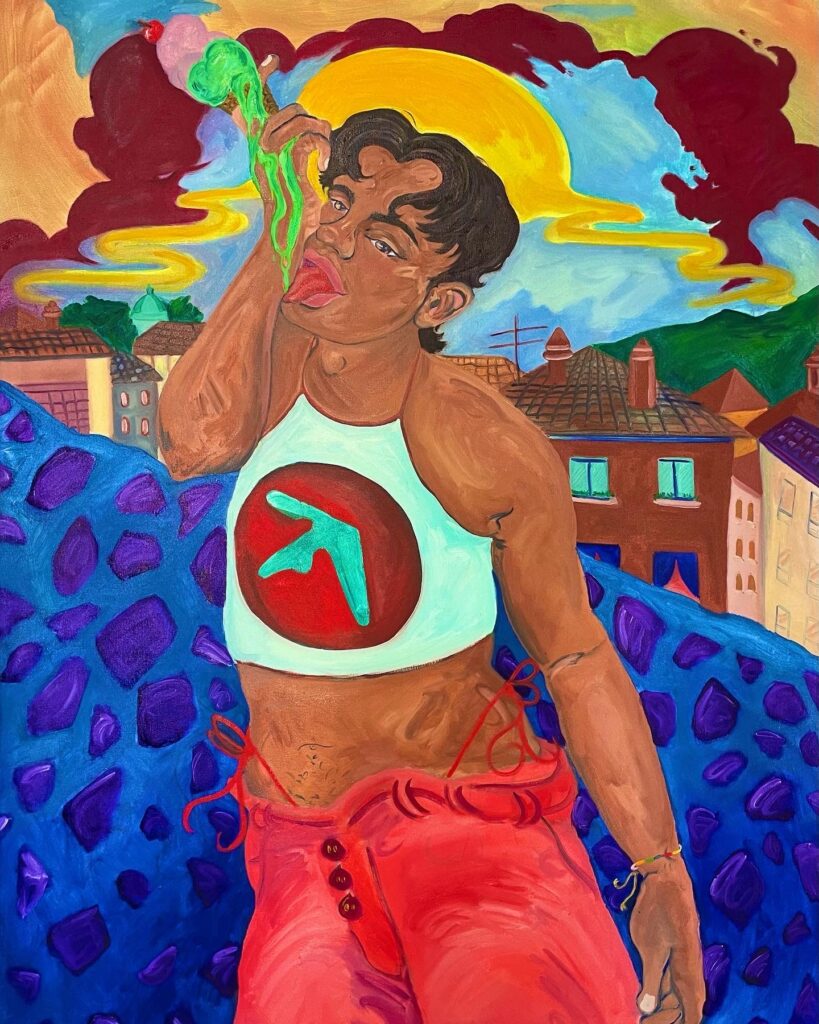
Text by Ottavia Lunari, Friday April 7, 2023
